
Algorithm
What Is An Algorithm ?
Algorithm Types And Features
Beginners complete guide to the basics of algorithm , what is an algorithm, how it works, types and Characteristics.
Introduction To Algorithm
An algorithm is a well-defined set of steps that can be followed to solve a particular problem or perform a specific task. Algorithms are used in many fields, including computer science, mathematics, and engineering.
In computer science, algorithms are used to develop software and computer programs, and to solve various problems related to computation. Algorithms are step-by-step procedures for solving problems, performing computations, or carrying out tasks.
They are used in a wide range of applications, from computer science and engineering to finance, biology, and many other fields.
An algorithm can be described in many different ways, including in natural language, in a flowchart, or in pseudocode. Pseudocode is a simple programming-like language that is used to describe algorithms in a way that is easy to understand and can be translated into a programming language later.
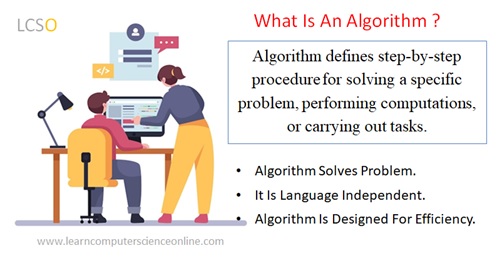
There are many different types of algorithms, including sorting algorithms, search algorithms, encryption algorithms, and compression algorithms. Each type of algorithm is designed to solve a specific problem or perform a specific task.
To analyse algorithms, computer scientists use various measures, including time complexity and space complexity. Time complexity refers to how long it takes an algorithm to run, and space complexity refers to how much memory an algorithm requires to run.
Designing and analysing algorithms is an important part of computer science and related fields. Researchers and practitioners in these fields seek to develop algorithms that are efficient, accurate, and reliable, and that can handle large volumes of data and complex problems.
Algorithms are a fundamental part of computer science and play a critical role in developing software and solving computational problems.
What Is An Algorithm ?
An algorithm is a set of well-defined instructions or steps that can be followed to solve a problem or perform a specific task. It is essentially a series of logical steps that can be executed to achieve a desired result. Algorithms can be expressed in various ways, such as natural language, flowcharts, or pseudocode.
In computer science, algorithms are used to develop software programs and solve various computational problems. For example, a search algorithm might be used to find a specific piece of information in a large database, while a sorting algorithm might be used to arrange a list of items in a specific order.
Algorithms can be classified into many different categories, including sorting algorithms, searching algorithms, graph algorithms, and optimization algorithms. Each type of algorithm is designed to solve a specific problem or perform a specific task.
Computer Programming And Algorithm
Algorithm and computer programming are closely related concepts. Algorithms are the step-by-step procedures used to solve a problem or perform a task, while computer programming involves writing code in a programming language to implement an algorithm and make it executable by a computer.
When developing a computer program, the first step is to design an algorithm that solves the problem at hand. The algorithm may be designed using pseudocode, a structured language that resembles code but is not tied to any specific programming language. Once the algorithm is designed, it can be translated into code in a specific programming language, such as Java, Python, or C++.
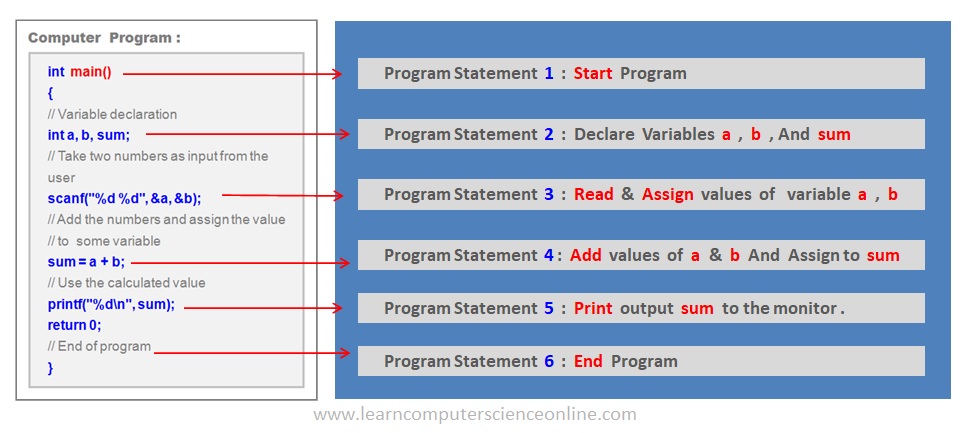
The programming language provides the syntax and structure necessary to implement the algorithm in a way that can be executed by a computer. Programmers use variables, data structures, conditional statements, loops, and other programming constructs to implement the algorithm and create a working program.
Good programming practices involve writing clear, efficient, and maintainable code that implements the algorithm correctly and handles errors and exceptions gracefully. Effective algorithms and well-written programs are essential for creating software applications that are reliable, scalable, and easy to use.
An Introduction To Computer
Importance Of Algorithm
Algorithms are an essential tool for solving complex problems and making sense of large amounts of data. They play a critical role in many areas of modern life, from business and finance to scientific research and engineering.
Algorithms are important for several reasons, including:
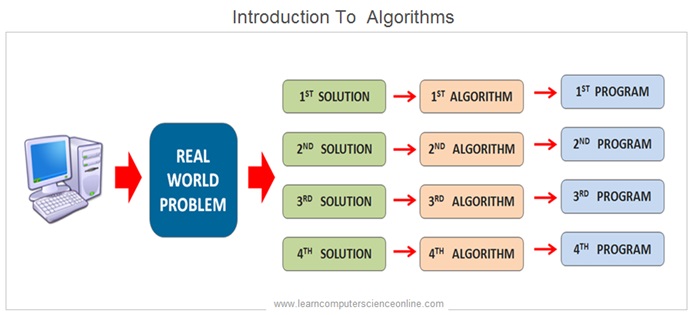
- Efficiency: Good algorithms can solve problems quickly and efficiently. This is particularly important in fields such as computer science and engineering, where large amounts of data must be processed and analysed in a timely manner.
- Scalability: Algorithms that are designed to handle large data sets and complex problems are essential in today’s world, where the amount of data being generated is increasing exponentially.
- Optimization: Many algorithms are designed to optimize a particular metric or goal, such as minimizing cost or maximizing efficiency. By using algorithms to optimize processes, companies and organizations can save time, money, and resources.
- Standardization: Algorithms provide a standardized way of solving problems, which can make it easier for people to communicate and collaborate with one another.
- Innovation: Developing new algorithms can lead to breakthroughs in technology and scientific research, as well as new applications in fields such as medicine, finance, and energy.
Characteristics Of Algorithm
The characteristics of an algorithm refer to the properties or features that an algorithm must possess to be considered a valid and effective solution for a problem. The key characteristics of an algorithm are as follows:
These characteristics ensure that an algorithm is a reliable and effective solution for a problem. By possessing these characteristics, an algorithm can be implemented and executed on a computer system to solve complex computational problems.
By following these characteristics, an algorithm can be designed to solve a particular problem or perform a specific task effectively and efficiently.
The characteristics of an algorithm are as follows:
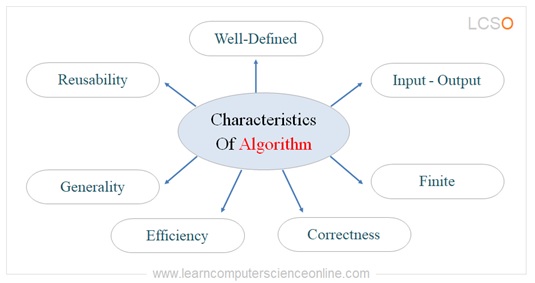
- Well-defined: An algorithm must be well-defined, which means that each step in the algorithm must be clear and unambiguous. This ensures that the algorithm can be executed correctly and consistently.
- Input: An algorithm must have an input, which is the data or information that the algorithm will process.
- Output: An algorithm must have an output, which is the result of the algorithm’s processing of the input.
- Finite: An algorithm must terminate after a finite number of steps. This means that the algorithm must have a stopping condition, so it does not run forever.
- Correctness: An algorithm must produce the correct output for every possible input. The algorithm must be designed to handle all possible input values.
- Efficiency: An algorithm must be efficient, which means that it should use the minimum amount of time and resources necessary to produce the desired output.
- Generality: An algorithm must be general, which means that it should be applicable to a wide range of input data and not be specific to a particular data set or problem.
- Reusability: An algorithm should be designed in such a way that it can be reused in different contexts and for different applications.
Applications Of Algorithm
Algorithms are critical to solving complex problems and making sense of large amounts of data in a wide range of applications. Algorithms have a wide range of applications in various fields, some of which are as follows:

- Computer Science: Algorithms are fundamental to computer science and programming. They are used to solve various problems like sorting, searching, and graph traversal.
- Artificial Intelligence: Algorithms are extensively used in artificial intelligence and machine learning to train models, perform pattern recognition, and make predictions.
- Cryptography: Algorithms are used in cryptography to encrypt and decrypt messages, verify digital signatures, and protect information from unauthorized access.
- Computational Biology: Algorithms are used in computational biology to analyze genetic data, identify patterns, and develop predictive models for disease diagnosis and drug discovery.
- Finance: Algorithms are used in finance for risk analysis, asset allocation, and trading strategies.
- Robotics: Algorithms are used in robotics to control the movement and behavior of robots, enable navigation, and support decision-making.
- Image and video processing: Algorithms are used in image and video processing to enhance images and videos, perform object detection and tracking, and recognize faces.
- Natural language Processing: Algorithms are used in natural language processing to analyze and understand human language, perform sentiment analysis, and generate human-like responses.
Types Of Algorithm
Each type of algorithm has its strengths and weaknesses, and the choice of algorithm will depend on the specific problem at hand and the resources available. There are several types of algorithms, as follows:
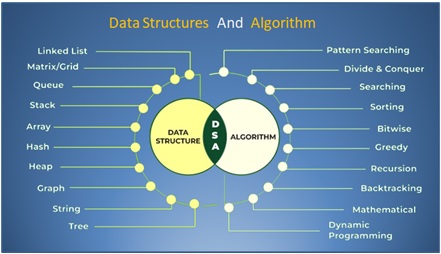
- Searching Algorithms: These algorithms are used to search for a specific value in a collection of data. Examples include linear search and binary search.
- Sorting Algorithms: These algorithms are used to sort data in a specific order, such as in ascending or descending order. Examples include bubble sort, quicksort, and merge sort.
- Graph Algorithms: These algorithms are used to traverse graphs and find paths between nodes. Examples include breadth-first search and depth-first search.
- Divide And Conquer Algorithms: These algorithms break down a problem into smaller sub-problems and solve each sub-problem independently. Examples include merge sort and binary search.
- Greedy Algorithms: These algorithms make decisions based on the current best option, without considering the long-term consequences. Examples include the knapsack problem and minimum spanning tree.
- Dynamic Programming Algorithms: These algorithms solve complex problems by breaking them down into smaller sub-problems and storing solutions to those sub-problems. Examples include the Fibonacci sequence and the longest common subsequence problem.
- Backtracking Algorithms: These algorithms explore all possible solutions to a problem by generating a tree of possibilities and backtracking when a solution is not found. Examples include the N-Queens problem and the subset sum problem.
- Randomized Algorithms: These algorithms use a random element to solve a problem, such as generating a random solution and evaluating its effectiveness. Examples include randomized quicksort and Monte Carlo algorithms.
Join The Best Seller
Computer Science Online Course
This is the most comprehensive and unique Computer Science And Programming Fundamentals course Online which will give you in depth understanding of most important fundamental concepts in computer science And Programming .


